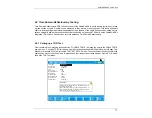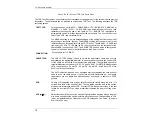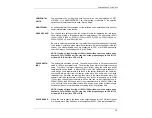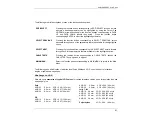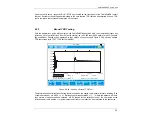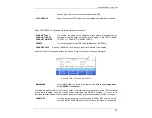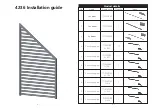
CableSHARK
P3
User Guide
91
800ns and look for any impairments up to 5000ft (1520m), and so on, until the cable end is found or the test
is completed. Wider pulse widths makes it easier to detect small faults on the cable or faults located at a
farther distance. Starting from the shorter pulse width is useful for locating any fault that may otherwise be
hidden in the blind spot (see 8.2.4.1 Blind Spots) of a sent pulse of wider width. Increasing the pulse width
gradually is necessary to avoid a pulse that is so wide that one reflection is hidden behind another or to
prevent the reflections from two or more faults from overlapping each other.
8.2.4.3 Reflection polarity
The phase relationship between the sent pulse and the reflected pulses can be used to determine the cause
of a reflection. Reflections from sharp, increasing points of impedance are in-phase; such as open-end, load
coil, lower impedance wire connected to higher impedance wire, series resistance fault, etc. Reflections
from sharp, decreasing points of impedance are out-of-phase, such as shorted end, connection point of a
bridge tap, higher impedance wire connected after lower impedance wire, wet splice, water in the cable etc.
8.2.4.4 Detecting Load Coils
For detecting load coils, it is easier to use the Load Coil Detection Test of the CableSHARK first, rather than
guess whether or not an open-like reflection is a load coil. If the Load Coil Detection Test indicates that
there is a load coil on the line, the user can use the TDR test to quickly locate and remove any load coils on
the cable.
When finding the location of load coils
with TDR
, remember that the waveform will generally show a more
rounded appearance than an open at the location of a load coil.
Load coils come in two values: the H88 (88mH), which is normally placed every 3000 ft (900 m) or 6000 ft
(1800 m) apart, and the D66 (66mH), which is normally placed every 4500 ft (1370 m) apart. Depending on
the location in the section, load coil spacing is very particular – at 3000 feet (900 m) or 6000 feet (1800 m)
intervals for H88 load coils. Suspect a load coil if you see an open-like reflection on the waveform at
approximately 6000 feet (1800 m) from the TDR, although not all load coils look the same. The first load coil
is all that you will see, since the TDR’s signal cannot pass through a load coil. Once you have found the first
load coil, remove it and retest the cable.
8.2.4.5 Test from Both Ends of the Cable
It is always good practice to test a cable from both ends to locate and confirm any faults. It can reduce errors
in the VOP setting and uncover any hidden faults. For example, there is a cable of 5000 ft (1500 m) length
with a fault located at 2000 ft (600 m) on a cable. If the test result shows that the fault is at 2050 ft (600 m)
when tested from one end and that the fault is at 3075 ft (930 m) when tested from the other end, it will
indicate that the VOP setting is too fast. If, in this case, the user tested only from the first end and started to
dig the ground to fix the fault, he or she would be digging in the wrong place.
Summary of Contents for CableSHARK P3
Page 1: ......
Page 10: ...VF DSL Cable Qualifier viii...
Page 12: ...VF DSL Cable Qualifier x...
Page 26: ...VF DSL Cable Qualifier 14...
Page 36: ...VF DSL Cable Qualifier 24...
Page 64: ...VF DSL Cable Qualifier 52...
Page 80: ...VF DSL Cable Qualifier 68...
Page 184: ...VF DSL Cable Qualifier 172...
Page 192: ...VF DSL Cable Qualifier 180...
Page 224: ...VF DSL Cable Qualifier 212...
Page 228: ...VF DSL Cable Qualifier 216...
Page 262: ...VF DSL Cable Qualifier 250 CSA Loop 6 CSA Loop 7 CSA Loop 8 Extended CSA Loop 9...
Page 263: ...CableSHARK P3 User Guide 251 Extended CSA Loop 10 Mid CSA Loop 0 Mid CSA Loop 1 Mid CSA Loop 2...
Page 264: ...VF DSL Cable Qualifier 252 Mid CSA Loop 3 Mid CSA Loop 4 Mid CSA Loop 5 Mid CSA Loop 6...
Page 265: ...CableSHARK P3 User Guide 253 ANSI Loop 2 ANSI Loop 3 ANSI Loop 4 ANSI Loop 5...
Page 266: ...VF DSL Cable Qualifier 254 ANSI Loop 6 ANSI Loop 7 ANSI Loop 8 ANSI Loop 9...
Page 267: ...CableSHARK P3 User Guide 255 ANSI Loop 11 ANSI Loop 12 ANSI Loop 13 ANSI Loop 15...
Page 268: ...VF DSL Cable Qualifier 256...
Page 286: ...VF DSL Cable Qualifier 274...
Page 292: ...VF DSL Cable Qualifier 280...
Page 294: ...VF DSL Cable Qualifier 282...
Page 316: ...VF DSL Cable Qualifier 304...
Page 318: ...VF DSL Cable Qualifier 306...
Page 319: ...CableSHARK P3 User Guide 307 Notes...
Page 320: ...VF DSL Cable Qualifier 308...

